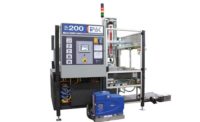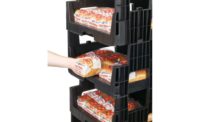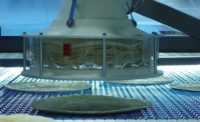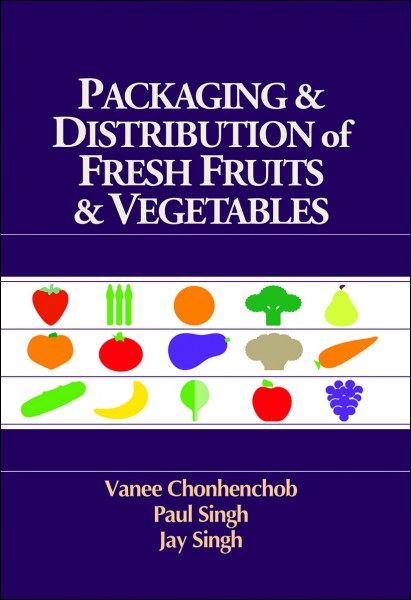Advanced secondary packaging solutions streamline distribution
Secondary packaging systems meet quick-changing market demands




Secondary packaging equipment can help snack producers and bakeries perform a variety of necessary functions, including shrink wrapping, shrink bundling, pallet unitizing and case building. The latest systems are also able to meet the demands of a quick-changing market.
Going retail-ready
“The warehouse/club channel is one of the areas where palletizing and bundling has found a new home,” says Sean Riley, senior director, media and industry communications, PMMI, Reston, VA. “Rather than utilization strictly as a mode of distribution in the supply chain, warehouse/club stores often keep the pallets intact and use them directly on the ‘sale’ floor as retail-ready displays.”
Muller, Glenview, IL, part of the Signode Industrial Group, offers Octopus stretch wrappers that feature automatic options such as corner board application, top cap application with tab folding and bottom tab folding, which give added protection to the palletized load. This is especially important for handling fragile packaged snack/bakery products.
“With more customers offering larger bag/carton sizes for the warehouse/club channel, goods often are packaged in display-type cartons that offer little protection and reduced pallet integrity. So it’s important to be able to automatically apply corner boards and top caps in the stretch wrapper. Otherwise, companies have to add these components manually off-line,” says Mark Corder, sales manager, Muller.
With retailers aiming to optimize shelf space and improve in-store operations, there’s growing demand for suppliers to utilize packaging that features a narrow shelf facing and relatively small shelf-ready trays. Delkor Systems’ Turbo Case shelf-ready package is designed to solve this problem and group together multiple small display trays into a single, reasonably sized shipper, according to Rick Gessler, vice president of marketing, engineering and production, Delkor Systems Inc., St. Paul, MN.
“By placing a top member over the trays and then shrink-bundling them into a single shippable unit, the trays are unified into a robust shipper that can handle the rigors of distribution. Currently on-shelf at retailers including Walmart and Kroger, the Turbo Case is ideal for baked snacks in tall canisters, tapered cups and other rigid containers,” Gessler says.
Advanced palletizing
The integration of various secondary packaging functions is the hallmark of many new systems. For example, AFA Systems Ltd., Brampton, Ontario, can integrate several auxiliary machines—stretch wrappers, pallet dispensers and slip sheet inserters—into its palletizers. “We also have a new solution that integrates case packing and palletizing on a single monobloc frame. These systems help improve overall warehouse and distribution efficiency, because they require less space and staff, and ensure high-quality packaging for the end user’s products,” says Eric Langer, sales and marketing director.
To eliminate waste associated with stretch wrapping, ARPAC, Schiller Park, IL, has developed the Zero Edge side seal apparatus, which can be used on a number of shrink wrappers. “Not only does eliminating the waste save money on film, the system also reduces downtime,” says Mike Allegretti, marketing and documentation manager.
Mark Collins, regional sales manager, Orion, Alexandria, MN, a ProMach brand, sees more consolidation of wrapping stations within bakeries, along with the use of higher-speed stretch wrapping to increase throughput. “For example, Orion worked with a bakery that had multiple wrappers at various locations wrapping 10 to 20 loads per hour. Now they have a central location turning out more than 65 pallet loads. They’ve also gained production space by eliminating individual wrapping stations.”
Kelly Watterworth, regional sales manager, Orion, says that innovative stretch wrapping can stabilize loads of warm or frozen baked goods. The technique of “roping” can be used on warm products to promote ventilation. Rather than covering the entire outside of the load with film, narrow bands of film stabilize the load, while giving the products room to breathe and cool. The same technique can be used for quick refrigeration.
“One customer was able to eliminate the need for metal cabinets to transport fragile fresh bread by using plastic trays and stretch-wrapped pallets. This increased the number of units per load and lowered the cost of transporting the cabinets back to the bakery. There was less handling, and the customer gained operational space because they did not have to store the cabinets. The baked goods arrived in comparable condition, but at less cost,” Watterworth explains.
Texwrap, Washington, MO, a ProMach brand, manufactures equipment than can shrink wrap pizzas, fresh cakes and other baked goods at speeds up to 150 units per minute. “We have shrink-wrap applications where trays of mixed products, such as chips or mixed baked goods, are placed directly onto the display shelf. These trays are supported by film, which reduces corrugated consumption and time spent handling the product,” says Al Kiggans, product manager.
New shrink-wrap film formulations add support for products. For example, a cake can come out of the oven and right into the shrink wrapper unsupported, which costs less. These unsupported packages of cakes are sent to retailers, where frosting and personalization are added, notes Kiggans.
“Brenton has the technology to build a pallet load to order and then ship that order direct to the retailer. Direct-to-order palletizing eliminates the need to ship products to a warehouse and then build orders by hand. This reduces shipping and warehousing time, and reduces labor and shipping costs,” says Jason Bennett, regional sales manager, Brenton, Alexandria, MN, a ProMach brand.
A supporting strategy for direct-to-order palletizing is the innovative use of accumulation conveyors, Bennett adds. “Design strategies can be used to minimize footprint. With advanced tracking and tracing software, each accumulation conveyor can be directed to release a specific case at a specific time for greater flexibility in pallet build. A central system like this eliminates multiple palletizing stations in the bakery and reduces the footprint of automation.” He also notes that Brenton has utilized a robot mounted on a rail to palletize mixed loads on multiple pallets.
A-B-C Packaging Machine Corp., Tarpon Springs, FL, recently introduced a small footprint palletizer, Model 72AN, that is designed for processors with limited floor space. It offers full flexibility for different products and is 25 percent smaller than standard models.
Improving worker safety via ergonomics is also an attractive feature. Verti-Lift, Louisville, KY, offers manual turntables that enhance ergonomics and productivity by eliminating the need to walk around or reach across loads, especially during pallet loading or unloading. These heavy-duty, low-profile turntables have a 1/2-inch-thick steel top turntable. Optional conveyor-topped models are available for in-process workstations.
Looking ahead to future advances in secondary packaging, Riley predicts that films will continue to get thinner as suppliers strive to offer more-sustainable solutions.
We’ll also likely look overseas for inspiration. “In Europe, we are already seeing the use of stretch hooding on cookies and crackers,” says Corder. “As film technology in North America catches up with Europe, this technology may offer an alternative to stretch wrapping, due to its increased pallet protection, tamper evidence and throughput advantages.”
Looking for a reprint of this article?
From high-res PDFs to custom plaques, order your copy today!











